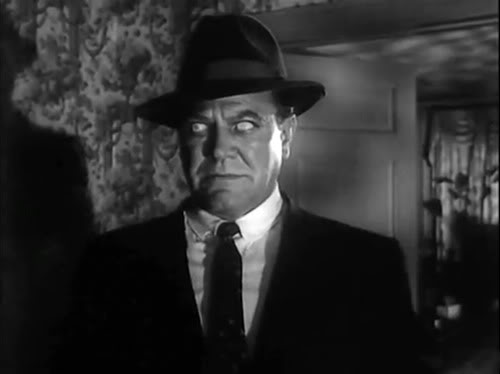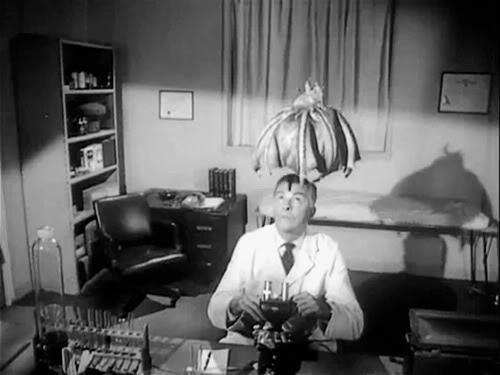"Satan's Waitin'" (1954) is a cartoon about death and is structured a bit like a classic Ten Little, Er, Indians style pick 'em off, of, if you prefer, a Bay of Blood style slasher picture. The twist is that we're watching the same victim bite it in colorful ways over and over, as Sylvester runs through his proverbial nine lives in seven minutes. The slasher in this case is the Devil in the form of a crimson bulldog, which is a metaphor for Sylvester's worst, obsessive, Tweety-hunting impulses, natch.
So here we have a couple of Freleng's own fixations on display, i.e. the neuroses and psychological torture of Sylvester (Tweety is barely in the cartoon except to motive the story and provide an ass joke when his tail feathers are yanked) and a certain philosophical morbidity that crept into his '50s shorts that is perhaps noirish or Hitchcockian or about the comic possibilities of Order and Chaos pressing and pulling at the weak soul of the cartoon animal Everyman. Whatever the conclusion I note a vague sense of postwar malaise in Freleng's work of this era, if not one totally distinct from other brands of malaise. This isn't a truism across the board, but when the quality is there, it is there in force, and not to be found with his peers. There is a terrible geometric order to "Satan's Waitin", to graphical wit, the pussycat and the canary on precarious chase across a sky carved by intersecting phone lines:
The most restrained, buttoned-down of Warner's major cartoon directors, Freleng's world is not populated with the flailing, screaming humanity of Bob Clampett's, his characters do not explore the complex, broad swath of human personality as Chuck Jones', his stories do not balloon out to the extreme proportions of Tex Avery's. And etc., not to tromp over a well-worn favorite stomping field of animation pundits; point is, speaking of formal issues of character animation, Freleng's cartoons don't squash as much, don't stretch as much, they don't antic as big, don't do takes that distort anatomical forms into graphical abstractions. Now all of this is of variable Trueness, depending on the staff for a particular short and who was actually animating a particular sequence, but certainly Freleng did not ask his animators to hit bigger, crazier poses, infuse acting with more personality and presence, or pick up the pace for the joy of speed. And on one hand, that is not as funny, and perhaps Freleng is puzzlingly lacking that cartoonist's gene that loves a funny drawing. On a different, more contemplative hand, stillness, stiffness, intellectual detachment and a cool demeanor can, indeed, provide a much different sort of comedy, on the Charles Schulz, Chris Ware sort of end of the comic spectrum.
Why was Freleng obsessed with Sylvester? It's not Tweety that the director is interested in — he defanged Clampett's sadistic-widdle-kid character and in design, function and performance drained the bird of a distinct personality rooted in human traits. Certainly every other director artist drew a funnier Sylvester, where Freleng pulled back on the character's previous stupidity and thuggishness. In place of the older Sylveter, here is one sweat-drenched and helpless in the face of his own compulsion.
Anyway, "Satan's Waitin'" is a study of graphic contrasts, spatial orientation, shapes and visual rhymes, and above, the hunter and prey locked in cycle scramble up a fire escape. The only reason to head to the rooftops in a cartoon like this is because someone is going down, and as it happens, Sylvester's journey up the fire escape ends in a pit of flame.
The abyss awaits! Hover. Hold. Beat. One of you is getting out of this alive.
So there's a cause/effect elegance to the cartoon's up/down see-sawing, doubled here as Sylvester's tail is his last erect extremity, then the tail flops down, then his soul springs up out of his butt in its place. A pair of brick and sidewalk square grids reinforce the visual order, but chaotic cracks in the cement emerge from under the cat's corpse, hinting at something else.
There is no tally provided of Sylvester's sins. He has simply Been a Bad Pussycat, and must take the red escalator every time, no matter, as we will eventually see, how he tries or what he does. The vagaries of moral rectitude flit around the fringes of "Satan's Waitin'", and the cat's only crime seems to be the attempted fulfillment of his natural predatory instinct, not that acting on instinct ever got anyone on the golden escalator. Though plenty of cartoons want to get in gags with wings and halos, I would naturally assume that all Looney Tunes characters are going to Hell.
Background painting people, do glance at the complimentary red and green buildings splitting the space between escalators.
Yawning chasm, fanged rock formations, spiraling conveyer belt to damnation.
The story here is that Sylvester's numbered lives must tarry in Hell's waiting room until all nine of their fellows have arrived. The structure is a countdown as the cat loses lives during the course of one long chase scene, with pit stops for exposition.
Life #2 arrives after a tangle with a steamroller. Again, scrambling life-drives are pinned and pressed into two dimensions and squeezed straight through the ceiling of Hell.
"Scare Your Girl," indeed. There are a handful of fine signage gags in this cartoon, another Freleng trademark, if not an exclusive one. Dig also this abandoned urban space, in the middle of an unpopulated city stands an empty carnival about to become a literal carnival of souls, lending an amplified quietude and desolation. There are production, budgetary and technical reasons for the minimal cast and lack of extras in animation, of course, and changing tastes in art and design have a lot to do with the modernist look of '50s and '60s WB cartoons. On the latter front, however, Freleng and Jones were usually ahead of the curve.
More nice muted primaries here; look how this says "carnival" and is all red, green and yellow but isn't just an out-of-tube eyeball cacophony. There's also a clue in the middle to a motif of Sylvester's being plagued by demons, and a big yellow paw that will pay off in a few scenes.
Nice dynamic staging. Noir-y, Third Many shadows that also popped up on Sylvester's first descent to Hell. There is a lot of movement along the z-axis in this cartoon.
Satan is everywhere.
Point demonstrated, I hope, about Freleng's comic reaction takes. Even the moment where Sylvester is so terrified that he dies is not much bigger than this.
Sylvester loses lives four through seven in rapid order on this shooting range. Though it is not different from any other cartoon shooting range, because of its place in this farce of certain destruction, this one seems a particularly apt, fatalistic metaphor: lined up, on track, ready to be blown apart. Also, more signage, more vague, useless moral instruction: "Shoot straight." Yes, good luck with that.
So, the way Freleng stages the gag here is to cut back to Satan's waiting room, as we hear gunfire, victory bells, and bang bang bang bang, dead cats are deposited in a row. There was probably a moment early in the film when we expected nine cat mangling vignettes. Confounding expectation, Freleng burns off four of Sylvester's lives in seconds.
Here begins the speediest sequence in the cartoon, and speaking of movement from back to fore, this roller coaster train slowly climbs the distant hill before rocketing downward — which is rather how we began this story. Then it charges at the viewer's damn face, which is a good deal more alarming than Arrival of a Train at La Ciotat, and then zooms over the screen. What's happening here, and in another directly-overhead shot of the train charging down a drop that I haven't pictured, is a) complicated staging with difficult angles, beautifully animated with mathematical precision...
b) more open space netted by intersecting lines, c) the visual rhyme and gag setup that is the reason the escalator to Hell was designed as a long, red, twisty track.
Point A above kind of makes up for the subdued character animation and mild gags. No doubt any other unit was up to the task of pulling off the scene, and if, say, it had been a Clampett, the scene would likely have the visceral impact of riding a roller coaster. Jones would have blessed it with his — how do put it? — peculiarly sardonic sense of physics, and both others would have done it all faster. But faster, gutsier and (ahem, funnier) bloodier is not the point, the point is the go-nowhere trip along a one-way track.
Relish the spare, allegorical quality of this particular pose, and the clever, don't-blink touch of marking the car #9. Because it's the little things.
I note for anyone without art inclinations that drawing this angle totally sucks.
This is the important part of this shot. Were this a Jones Roadrunner cartoon, the timing, the drawing, the sound effect would make the moment of impact the joke, maybe with a microbeat of I-fucked-up Coyote recognition before the carnage. Here it is the belated behavioral instruction that is impossible to follow, and doom rushing at one's head.
Payoff. Probably the funniest cut in the cartoon is between the coaster massacre and the above match, Life #8 blank-eyed, silent, no reason to fight this anymore.
Meanwhile, topside, Sylv takes the "Time Enough at Last" approach and seals himself up in a bank vault. Not trusting his unrestrainable urges, and trying to minimize the universe's chaotic x-factor input, he goes on defense. We'll note yet again that this designy vault is all grids, quads and circles, and fair enough, Everything is Shapes, but '50s design only emphasizes this fact (and my roundabout point is that the cartoon is kind of in dialog with that idea).
Naturally, Satan being Everywhere, two bungling robbers try to dynamite open the vault and kill everyone in the process. And on that front:
-The last manifestation of "Satan's Waitin'"'s thematic/visual theme of agents of explosive chaos and confining order sort of luring then breeching one another. Also crime does not pay, but neither does not doing crimes.
-A mild send-up of atomic age bomb shelter mentality.
-Another cut-to-result staging of a violence gag. Freleng doesn't show the explosive, the explosion or the corpses, just:

























